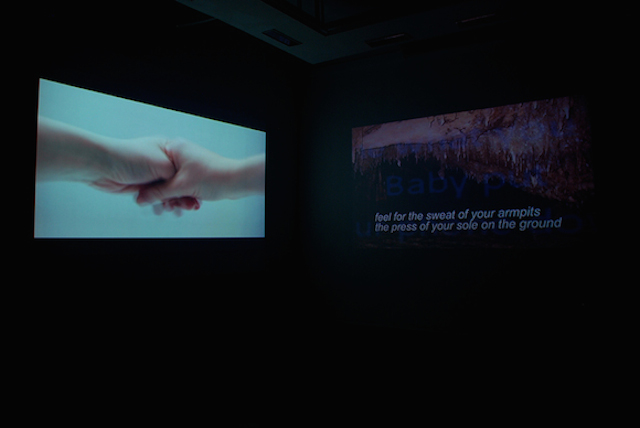
(left) Saoirse Wall. you only need follow the rules, and all will be well, 2014. Right: Hannah Black. My Bodies, 2014. Courtesy of the artists.
Gaby Cepeda, an independent curator based in Lima, Peru, founded the Girls of the Internet Museum as a way to archive Internet works made by an international group of women. Controlled and personified, social media has become a haven for feminist exploration; artists are now carefully constructing the ways in which their bodies are presented and consumed. Cepeda discusses how these practices are reconstructing the self-as-performance, allowing artists to consider gender identity, politics, and emotional relationships through the openness of virtual communities.
Alexis Avedisian (AA): When did the Girls of the Internet Museum (GIM) form? How did you meet the self-identified women with whom you have been collaborating through this platform?
Gaby Cepeda (GC): In late 2012, I took a seminar with the Mexican curator Pablo León de la Barra about the creation of what he called “spontaneous exhibitions and express museums.” It was mostly centered on his curatorial practice, in which he conceives of informal and/or temporary exhibition-display technologies. At the end of the seminar, he asked the participants to create their own institutions.
Tumblr seemed an accessible venue for this. I was beginning my thesis research, focused on Internet art made by women, and wanted the GIM to exist beyond the expectations of impersonal, academic research. I met all of the self-identified women who are part of the collection through the Internet, with the exception of the Buenos Aires artist Adriana Minoliti, who has become a great influence to the GIM.
AA: It’s interesting that the GIM evolved from a research project about ephemeral curatorial practice; while GIM has an eternal archive (at least as long as Tumblr exists), many of the works stem from more traditional ephemera. How do you think screen-based works are continuing to shape the ways in which time, place, and the body are encapsulated in art?
GC: I don’t really perceive the Internet as eternal. I don’t know what kind of fate my MySpace account faced or if my GeoCities website will ever be unearthed by projects such as Olia Lialina’s archaeological project. The next generations of Internet users will probably think our early interactions are quaint, asking, “What do you mean by ‘Girls of the Internet’? Who is not on it?” Hopefully they’ll also ask, “What is gender?”
I find that video as a medium has changed and has become a lot more malleable since it began inhabiting the Web. It has expanded the artist-as-performer category, in which the artist performed with their own body; due to the availability of data, artists also began to interact and perform with information. I’m thinking of Hannah Black’s video My Bodies, in which she is performing through text and language. And Shawné Michaelain Holloway in her work performs as a flickering, super-sexual character in an almost physical interaction with browsers.
These sorts of interactions, between actual bodies and digital information, has allowed bodies on video to not only be re-signified, to be added to and edited, but also amalgamate other histories and meanings. Endlessly looping GIFs pose a strange challenge to durational performance: an unachievable infinity of gesturing bodies.
AA: The tagline for GIM is “we’re into ~sincerity.” There has been ample dialogue about the concept of feminized sincerity presented within a capitalist space such as the Internet. What is your definition of sincerity in relation to the works you’ve exhibited?
GC: Since it was founded, the GIM has been exploring the question of sincerity. Women’s practices tended to explore more reflexive, earnest possibilities. Even stereotypically girly visual content seemed to come from a genuine place, a sort of nostalgic self-exploration that led to reinterpretation.
It’s clear that women found a way to subvert the mass media’s image of female bodies and its narratives by assuming control of their depictions on the Internet; that this, in turn, has been appropriated by the market seems unavoidable. The Internet is a reflection of our capitalist reality, one that is never outside of it; I don’t think we have much left that hasn’t been subjected to market logic and its narratives. It sounds bleak, but I think it’s true. In a way, I think sincerity in this landscape is something akin to questioning these elaborate, all-encompassing narratives, pointing to the huge holes in it.
When images of bodies are put online, and thus commodified or turned into information, not all bodies are perceived, consumed, or distributed in the same way, especially female-identified bodies. In this, the Internet is not different from the physical world; women face the same difficulties and stereotyping in reality that they face online, increasing the feelings of vulnerability. Yet the Internet has also provided spaces where vulnerability is welcome and dialogue among peers is encouraged. The GIM is one of these spaces, in which different artistic practices, perspectives, and discourses can coexist.
Shawné Michaelain Holloway. a_personal_project, IV: password protected thaumatrope, security measures for a caged bird.mov, 2014. Courtesy of the artist.
AA: How do you see art institutions becoming more invested in including internet-based works within their programming?
GC: I think that as the Internet becomes more inclusive, and more backgrounds and geographies are represented, it will inevitably become more prominent in institutions. I say this from the perspective of a person living in Latin America: yes, a lot of people have smartphones and access to the Internet, but artists making Internet-based works in Latin America are much less common than in the First World art capitals. The spaces dedicated to ‘net art tend to only look at their immediate geographical settings, which is strange, considering how the Internet is usually depicted as a very democratic, open platform. In reality, the lack of diversity is evident.